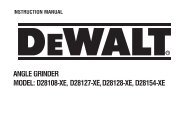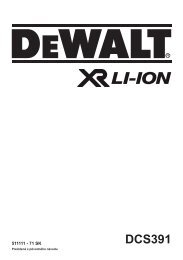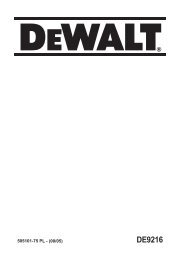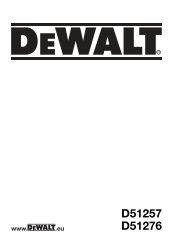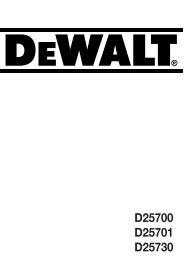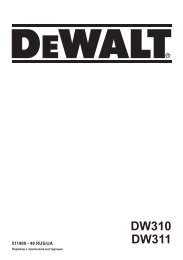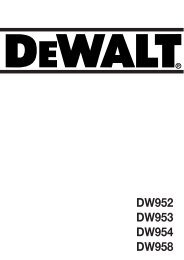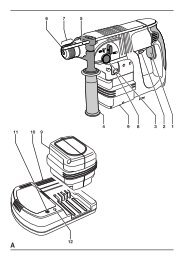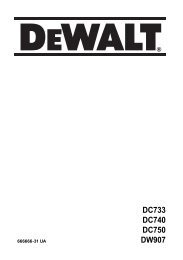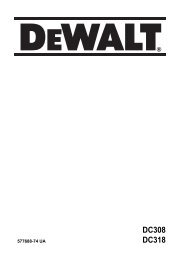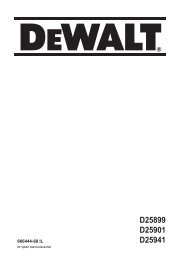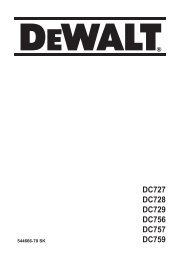You also want an ePaper? Increase the reach of your titles
YUMPU automatically turns print PDFs into web optimized ePapers that Google loves.
ENGLISH<br />
• Keep the surrounding area of the machine well maintained and free<br />
of loose materials, e.g. chips and cut-offs.<br />
• Check periodically that the motor air slots are clean and free of chips.<br />
• Replace the kerf plate when worn.<br />
• Disconnect the machine from the mains before carrying out any<br />
maintenance work or when changing the blade.<br />
• Never perform any cleaning or maintenance work when the machine<br />
is still running and the head is not in the rest position.<br />
• When possible, always mount the machine to a bench.<br />
• If you use a laser to indicate the cutting line, make sure that the laser<br />
is of class 2 according to EN 60825-1:2001. Do not replace a laser<br />
diode with a different type. If damaged, have the laser repaired by an<br />
authorised repair agent.<br />
• When performing vertical straight cross-cuts, adjust the sliding fence<br />
correctly to ensure a clearance of max. 5 mm between the saw blade<br />
and the fence.<br />
• When performing mitre, bevel or compound mitre cuts, adjust the<br />
sliding fence to ensure the correct clearance for the application.<br />
• Refrain from removing any cut-offs or other parts of the workpiece<br />
from the cutting area while the saw is running and the saw head is<br />
not in the rest position.<br />
Additional safety rules for saw benches<br />
• Do not use saw blades with a body thickness greater or a width of<br />
tooth smaller than the thickness of the riving knife.<br />
• Make sure that the blade rotates in the correct direction and that the<br />
teeth are pointing to the front of the saw bench.<br />
• Be sure all clamp handles are tight before starting any operation.<br />
• Be sure all blade and fl anges are clean and the recessed sides of the<br />
collar are against the blade. Tighten the arbor nut securely.<br />
• Keep the saw blade sharp and properly set.<br />
• Make sure that the riving knife is adjusted to the correct distance<br />
from the blade - maximum 5 mm.<br />
• Never operate the saw without the upper and lower guards in place.<br />
• Keep your hands out of the path of the saw blade.<br />
• Disconnect the saw from the mains supply before changing blades or<br />
carrying out maintenance.<br />
• Use a push stick at all times, and ensure that you do not place hands<br />
closer than 150 mm from the saw blade while cutting.<br />
• Do not attempt to operate on anything but the designated voltage.<br />
• Do not apply lubricants to the blade when it is running.<br />
• Do not reach around behind the saw blade.<br />
• Always keep the push stick in its place when not in use.<br />
• Do not stand on top of the unit.<br />
• During transportation make sure that the upper part of the saw blade<br />
is covered, e.g. by the guard.<br />
• Do not use the guard for handling or transportation.<br />
• Adjust the sliding fence correctly to avoid contact with the lower guard.<br />
• Ensure that the table is securely fi xed.<br />
• Do not use the saw for cutting any material other than wood.<br />
• Slotting, rebating or grooving is not allowed.<br />
Additional safety rules for table top mitre saws<br />
• Do not allow untrained people to operate this machine.<br />
• Whenever you use the machine, report any faults in the machine as<br />
soon as they are discovered.<br />
30<br />
This machine is equipped with a specially confi gured power<br />
supply cord (type M attachment). If the power supply cord is<br />
damaged or otherwise defective, it must only be replaced by<br />
the manufacturer or by an authorized repair agent.<br />
• For your own safety, always secure the machine to a workbench or<br />
a suitable chipboard plate with the minimum dimensions of<br />
1000 x 1000 x 22 mm. Use fasteners of 5 mm bolts or larger with<br />
a suitable length.<br />
• Ensure that bystanders do not stand behind the machine.<br />
• When the saw blade is jammed in the workpiece, always switch off<br />
the machine before removing the workpiece.<br />
• Ensure that the upper portion of the saw blade is completely<br />
enclosed in the mitre sawing mode. Never remove the upper blade<br />
guard when using the machine in mitre saw mode.<br />
• Ensure that the arm is securely fi xed when sawing in the bench saw<br />
mode.<br />
• Make sure that the upper and lower guard are in place in the bench<br />
saw mode. Only use the machine when the saw bench table is in<br />
horizontal position.<br />
Residual risks<br />
The following risks are inherent to the use of saws:<br />
- injuries caused by touching the rotating parts<br />
In spite of the application of the relevant safety regulations and the<br />
implementation of safety devices, certain residual risks cannot be<br />
avoided. These are:<br />
- Impairment of hearing.<br />
- Risk of accidents caused by the uncovered parts of the rotating saw<br />
blade.<br />
- Risk of injury when changing the blade.<br />
- Risk of squeezing fi ngers when opening the guards.<br />
- Health hazards caused by breathing dust developed when sawing<br />
wood, especially oak, beech and MDF.<br />
- Risk of injury caused by parts of the workpiece hurled at bystanders.<br />
- Risk of accidents caused by fl ying metal particles when cutting into<br />
the fence.<br />
- Fire hazard due to extreme dust concentration when not cleaned<br />
regularly.<br />
- Risk of uncontrolled situations when used in ambient temperatures<br />
below -10 °C or above +45 °C.<br />
The following factors are of infl uence to noise production:<br />
- the material to be cut<br />
- the type of saw blade<br />
- the feed force<br />
The following factors are of infl uence to dust exposure:<br />
- worn saw blade<br />
- dust extractor with air velocity less than 20 m/s<br />
- workpiece not exactly guided<br />
Labels on tool<br />
The following pictograms are shown on the tool:<br />
Safe use warning<br />
Read the instruction manual before use<br />
When using the machine in the mitre saw mode, make sure<br />
that the upper part of the saw blade is fully covered by the<br />
upper saw blade guard. Only use the machine when the<br />
bench saw table is in highest position.<br />
When using the machine in the bench saw mode, make sure<br />
that the upper and lower guards are in place and functioning<br />
properly. Only use the machine when the bench saw table is<br />
in horizontal position.<br />
When making a sliding cut in mitre saw mode, observe the<br />
instructions as provided under "Performing a sliding cut".<br />
Carrying point.




